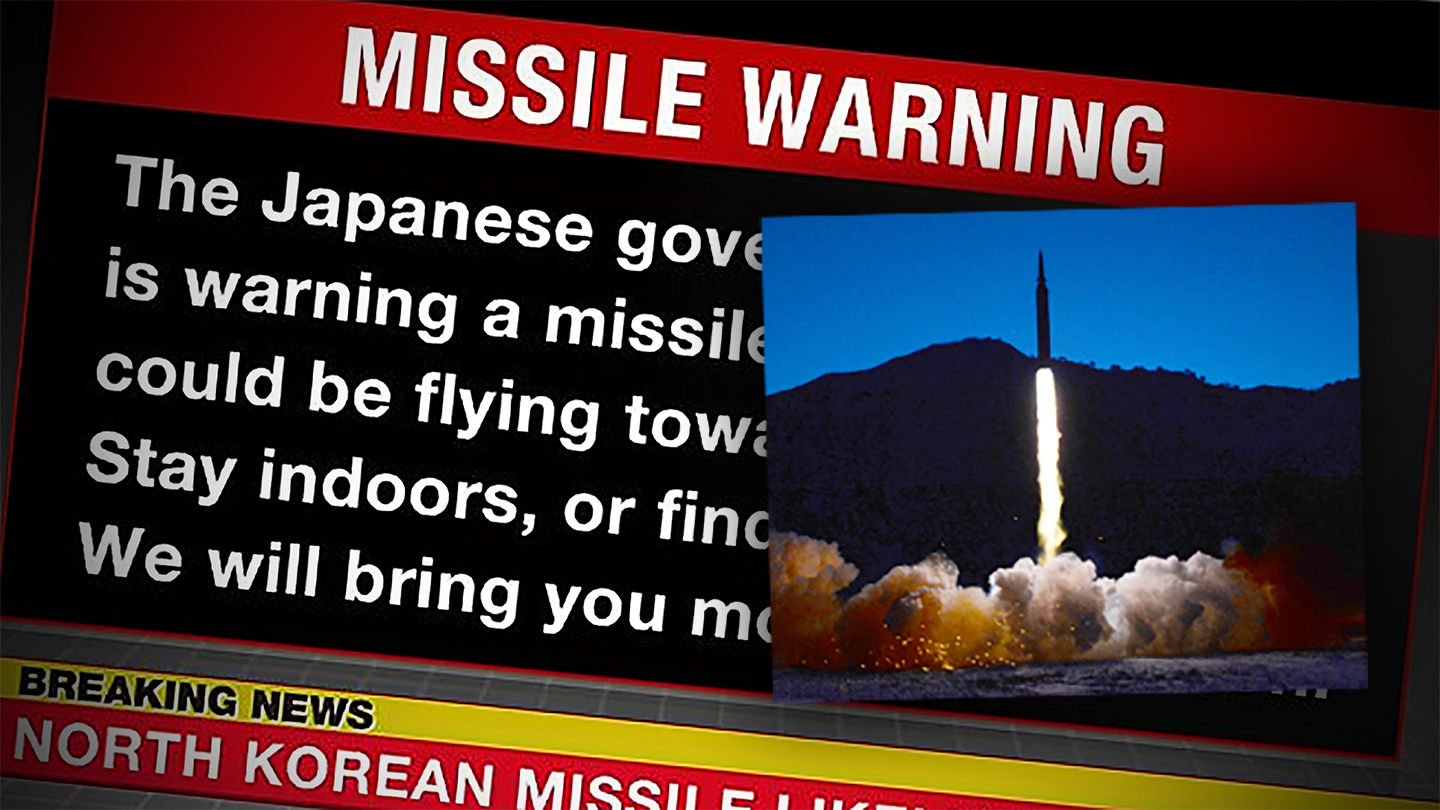The Japanese government warned people to seek shelter Tuesday morning Tokyo time after North Korea launched what appeared to be a ballistic missile that flew over the island nation and landed in the Pacific Ocean.
The “likely ballistic missile” launched by North Korea “flew over Japan and landed in the Pacific Ocean,” the Japanese Prime Minister’s office said, according to the Washington Post.
Before the missile landed, the Japanese government issued a warning to residents that the target was potentially Hokkaido and urged people to “seek shelter immediately…Please evacuate to the inside of a building or go to a basement.”
This launch marks Pyongyang’s fifth in 10 days, according to Reuters, “amid military muscle-flexing by the United States and South Korea, which staged trilateral anti-submarine exercises last week with Japanese naval forces.”
While North Korea often fires missiles when its leader Kim Jong Un is agitated or wants attention, this appears to be the first time since 2017 that one has overflown Japan.
On Sept. 14, 2017, North Korea conducted its longest downrange ballistic missile test to date with a provocative launch over Japan, showing it has at least the range to hit the U.S. Pacific Ocean territory of Guam. The incident came after the United Nations Security Council hit the increasingly isolated country with the toughest sanctions to date.
On that date, the North Koreans fired what appeared to be a Hwasong-12 intermediate-range ballistic missile. It reached a maximum altitude of approximately almost 480 miles and traveled a total distance of around 2,300 miles, over the Japanese home island of Hokkaido, before falling into the Pacific Ocean some 17 minutes later. This was particularly notable since it was a much shallower launch envelope than in previous tests and more representative of what one might expect to see in an actual strike.
You can read much more in our story about that incident here.
This is a developing story. We will update it with more information as it comes in.
Contact the author: howard@thewarzone.com
Update 8:17 PM EST:
South Korea’s Joint Chiefs of Staff (JCS) said it detected the launch from Mupyong-ri in the northern province of Jagang at 7:23 a.m. and that the missile flew past Japan, according to the Yonhap News Agency. It did not provide additional details.
“While strengthening our monitoring and vigilance, our military is maintaining a full readiness posture in close cooperation with the United States,” the JCS said in a text message sent to reporters.
According to Yonhap:
Pyongyang last fired an Intermediate Range Ballistic Missile in January. The Hwasong 12-type missile flew some 800 kilometers (about 500 miles) at a top altitude of 2,000 km (about 1,240 miles).
The North launched one short-range ballistic missile (SRBM) on Sept. 25, then two last Wednesday, another two the following day and two on Saturday.
Update 8:54 PM EST:
South Korean President Yoon Suk Yeol said North Korea launched an intermediate-range missile with a range of 4,000 kilometers (2,485 miles), according to The Associated Press. It is a range that places Guam within striking distance.
Yoon said he called a National Security Council meeting to discuss the launch and that the North’s “reckless nuclear provocations” would meet the stern response of the South and the broader international community.
Update 10:32 PM EST:
South Korea’s Ministry of Unification (MOU) “is unable to reach the North via [the inter-Korean] liaison hotline, Soo Kim, a former CIA Korea analyst who is now an analyst at RAND, said in a Tweet Monday night citing Yonhap.
The MOU is investigating why is has not been able to reach North Korean officials, said Kim, who focuses on national security and policy issues in the Indo-Pacific, the intelligence community, and U.S. homeland security.
“The North had not answered an opening call through an inter-Korean liaison communication line as of 9 a.m., while the military hotline was in normal operation,” an MOU official said, according to Yonhap, adding the government is trying to find out the reason amid the possibility of a technical problem.
The two Koreas hold phone calls twice a day via their joint liaison office channel.
MOU was created in 1969 “as a government body responsible for all issues pertaining to inter-Korean relations and unification.”
Update 11:59 PM EST:
U.S. Indo-Pacific Command (INDOPACOM) says it is “aware of the [North Korean] ballistic missile launch today, including that it overflew Japan.”
INDOPACOM officials “are consulting closely with Japan and the Republic of Korea (ROK), as well as other regional allies and partners, to address the threats posed by” North Korea, officially known as the Democratic People’s Republic of Korea, or DPRK. “The United States condemns these actions and calls on the DPRK to refrain from further unlawful and destabilizing acts.”
“While we have assessed that this event does not pose a threat to U.S. personnel, or territory, or to our allies, we will continue to monitor the situation. The U.S. commitments to the defense of Japan and the ROK remain ironclad.”
